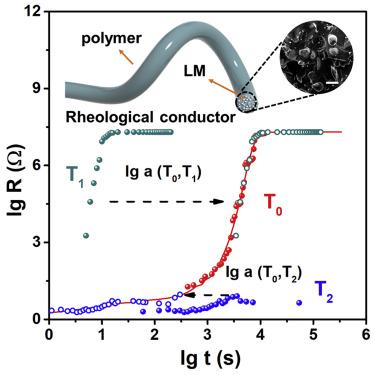Matter ( IF 18.9 ) Pub Date : 2021-07-28 , DOI: 10.1016/j.matt.2021.06.046 Yan Peng 1 , Huaizhi Liu 1 , Yumeng Xin 1 , Jiuyang Zhang 1

|
Advanced conductors are indispensable circuit elements in modern electronics with unique responses to environmental variations. This work successfully introduces the intriguing polymer relaxation into conductive materials and creates a special rheological conductor (RhC) from liquid metal (LM)-polymer composites. The electrical transition temperatures of RhC are found to be highly consistent with polymer rheological transition temperatures (Tg and Tf). Similar to the time-temperature superposition of polymers, a master curve can be constructed to effectively predict the conductivity of RhC. Further polymer rheological experiments and theoretical analysis successfully demonstrate the relationship between conductance and polymer chain relaxation. The RhC could realize several orders of magnitude change in resistance via temperature/time regulation. The polymer chain dynamics provide multiple resistive responses of RhC to temperature, time, and voltage that are remarkably different from traditional conductors. This work pioneers a new route to re-consider flexible conductors and provides diverse applications in high-tech devices.
中文翻译:

液态金属-聚合物复合材料的流变导体
先进导体是现代电子产品中不可或缺的电路元件,对环境变化具有独特的响应能力。这项工作成功地将有趣的聚合物弛豫引入了导电材料,并从液态金属 (LM)-聚合物复合材料中创造了一种特殊的流变导体 (RhC)。发现 RhC 的电转变温度与聚合物流变转变温度(T g和 T f)。类似于聚合物的时间-温度叠加,可以构建主曲线来有效预测 RhC 的电导率。进一步的聚合物流变实验和理论分析成功地证明了电导率和聚合物链松弛之间的关系。RhC 可以通过温度/时间调节实现几个数量级的电阻变化。聚合物链动力学提供了 RhC 对温度、时间和电压的多重电阻响应,这些响应与传统导体显着不同。这项工作开创了一条重新考虑柔性导体的新途径,并在高科技设备中提供了多种应用。



























 京公网安备 11010802027423号
京公网安备 11010802027423号